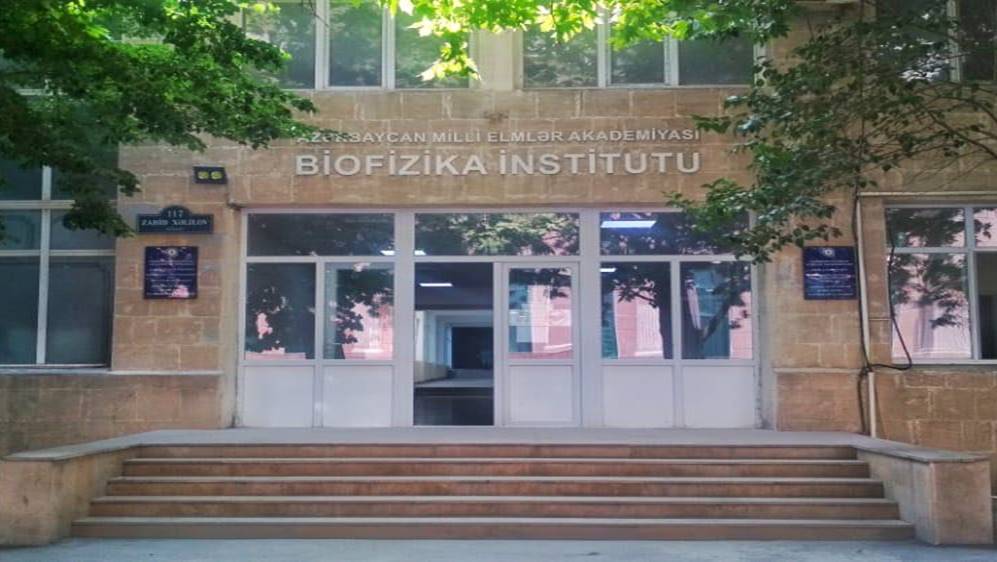
Institute of Biophysics
Ministry of Science and Education of the Republic of Azerbaijan
General Director of the Institute, Doctor of Physical and Mathematical Sciences, Professor, Corresponding Member of ANAS Oktay Gasymov
Institute of Biophysics was established in 2016. The meeting of the Nobel laureate Ahmet Ziveil, who participated in the Baku International Humanitarian Forum in 2011, with the President of the country Ilham Aliyev, and a few years later, at the International Humanitarian Forum in 2013 and at the general meeting dedicated to the 70th anniversary of ANAS in 2015 Another Nobel laureate, George Smoot, who spoke, repeatedly mentioned the importance of biophysical work to the head of state. George Smut addressed the president of ANAS, academician Akif Alizadeh and expressed his interest in developing biophysical research in Azerbaijan and his interest in directly participating in this work.
Thus, the structure that started functioning as a Center under the Physics Institute of ANAS started functioning as an independent Biophysics Institute from July 2016. The main task of this newly established institute is to conduct fundamental researches related to human health in the field of biophysics and to help their transfer to practice and medicine. First of all, important topics for Azerbaijan will be selected and developed as priority research areas.
Both physiological and pathological processes in the human body are to one degree or another directly related to the normal function or dysfunction of certain specific proteins. The study of the relationship between the structure-dynamics and function of proteins will allow determining the molecular mechanism of many serious diseases, including cancer, and fighting them at the molecular level by creating targeted nano-structures. In order to perform these tasks, both biophysical, biochemical and molecular biological methods have been created and developed at the Institute of Biophysics.
The main scientific direction of the Institute of Biophysics: Physico-chemical foundations of biological systems.
This direction includes:
1. Age-related neurodegenerative diseases caused by protein aggregation (amyloid) (Alzheimer's, Parkinson's, etc.) conducting
2. Study of the relationships between the structure, dynamics and function of biomolecules, especially biological macromolecules, the genetic and biochemical bases of the network of internal and external signals that regulate cell metabolism - protein-protein, protein-nucleic acid (protein-DNA, protein-RNA) and protein- study of membrane lipid connections.
3. To study the dynamics of cancer and healthy cell membranes, to discover their differences, to create liposome models of cancer and healthy cell membranes, to obtain cell membrane model monolayers using different phospholipids, and to interact with lipid components of various drugs and anti-cancer molecules. to study the effect. Creating systems that provide effective drug delivery to cancer cells using nano-proteins of various sizes (currently nano-Albumin protein is purchased and studied) and using them.
4. Creation of inexpensive and quick diagnostic methods based on Infrared spectra of blood plasma samples and fat fractions extracted from them with the application of Artificial Intelligence and bringing them to the level of wide application (screening). Obtaining silver and gold nanosheets and applying them to Surface Enhanced Raman scattering for highly sensitive determination of various drug molecules.
5. To determine the mechanisms of interaction between anti-cancer agents and receptor- and non-receptor tyrosine kinase proteins, which ensure continuous growth of cancer cells, using modern docking programs.
6. Organization of studies on identification and detection of mutations occurring in genes encoding receptor and kinase proteins that cause cancer, as well as taking prospective steps towards elimination or silencing of uncontrolled cell proliferation caused by these mutations.
7. Mathematical modeling of multicomponent kinetic processes in biological systems: study of mechanisms of genetic regulation of metabolic systems and networks formed by these systems in humans and model organisms; mathematical modeling of cancer progress, prediction and creation of relevant diagnostic systems for determining the main genetic factors that cause the formation of cancer cells.
8. Study of ion channels from membrane proteins and the membrane potential and electrical signals resulting from the activity of these channels, the development of electrophysiology and the study of the mechanisms of the development of severe diseases caused by the abnormal functioning of these processes, especially cancer and nerve (neurological) diseases.
9. Development of cell junctions - hybridomas - and conducting immunological studies for the production of monoclonal antibodies is planned as an important research direction.
10. Study of the role of external factors, including hypoxia, heavy metals and electromagnetic radiation, in the development of cancer and neurodegenerative diseases.
The following scientific laboratories operate under the Institute of Biophysics.
· Structure, dynamics and function of biomolecules (laboratory head, corresponding member of ANAS, Ph.D., Prof. Oktay Gasimov) ;
· Molecular and cellular biochemistry (laboratory head, Dr. Karim Gasimov) ;
· Joint laboratory of molecular and cellular oncology (leaders: Corresponding member of ANAS, Prof. Oktay Gasimov and Ph.D. Leilakhanim Malikova (National Oncology Center of the Ministry of Health of the Republic of Azerbaijan);
· Laboratory of biophysics of physico-chemical stress factors (laboratory head, Ph.D., Assoc. Sevinj Jafarova);
· Integrative biology (head of the laboratory, corresponding member of ANAS, Ph.D., Ilham Shahmuradov);
· Laboratory of cell signal transduction (head of the laboratory, Ph.D., Assoc. Yusifov Taleh).
It should be noted that these laboratories are scientifically complementary and closely cooperated with each other.
